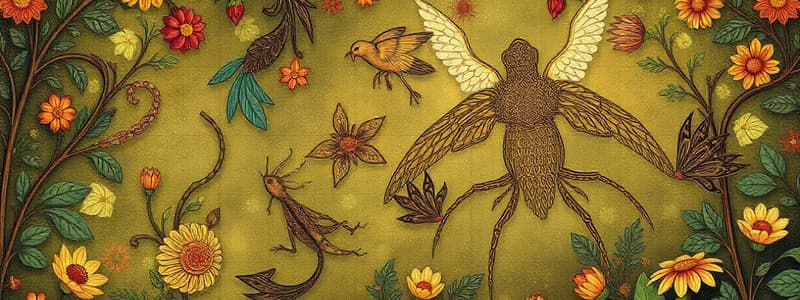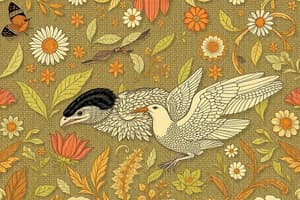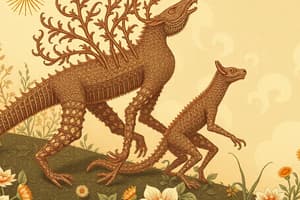Podcast
Questions and Answers
Which of the following is NOT a characteristic of convergent evolution?
Which of the following is NOT a characteristic of convergent evolution?
- Examples include the giant anteater and echidna, or aerial rootlets in English ivy and wintercreeper
- Two species from different lineages develop similar characteristics due to similar environments
- The species are not closely related evolutionarily
- The species are closely related evolutionarily (correct)
What is the defining characteristic of endemic species?
What is the defining characteristic of endemic species?
- They have evolved through artificial selection
- They are found only in a particular location (correct)
- They are found on islands only
- They are highly adapted to cold environments
What is the difference between natural selection and artificial selection?
What is the difference between natural selection and artificial selection?
- Natural selection is a process that occurs in nature, while artificial selection is a process that is controlled by humans
- Natural selection occurs in all organisms, while artificial selection only occurs in domesticated species
- Natural selection favors traits that increase an organism's fitness, while artificial selection favors traits that are desirable to humans (correct)
- Natural selection involves changes over long periods of time, while artificial selection happens quickly
Which of the following is NOT an example of homology?
Which of the following is NOT an example of homology?
What is the key evidence for the evolutionary relationship between humans and other vertebrates?
What is the key evidence for the evolutionary relationship between humans and other vertebrates?
What is the significance of the p53 gene being found in a diverse array of species?
What is the significance of the p53 gene being found in a diverse array of species?
Which of the following is an example of a vestigial structure?
Which of the following is an example of a vestigial structure?
What is the main difference between orthologs and paralogs?
What is the main difference between orthologs and paralogs?
What is the primary reason for the similarity between the three largest chromosomes in humans and apes?
What is the primary reason for the similarity between the three largest chromosomes in humans and apes?
Which of the following best describes the evolutionary significance of the difference between human chromosome 2 and the corresponding chromosomes in apes?
Which of the following best describes the evolutionary significance of the difference between human chromosome 2 and the corresponding chromosomes in apes?
How can horizontal gene transfer be described?
How can horizontal gene transfer be described?
What is the main function of the globin genes?
What is the main function of the globin genes?
What is the evolutionary significance of paralogs?
What is the evolutionary significance of paralogs?
What is the primary driver of beak diversity in Galapagos finches?
What is the primary driver of beak diversity in Galapagos finches?
What is a transitional fossil?
What is a transitional fossil?
What is the significance of the evolutionary changes observed in the horse lineage?
What is the significance of the evolutionary changes observed in the horse lineage?
What is the process called when genes are exchanged across unrelated taxa?
What is the process called when genes are exchanged across unrelated taxa?
Which of the following is a reliable method for determining evolutionary relationships between species?
Which of the following is a reliable method for determining evolutionary relationships between species?
What is the main reason why islands often have a high number of endemic species?
What is the main reason why islands often have a high number of endemic species?
Which of the following is an example of artificial selection?
Which of the following is an example of artificial selection?
Which of the following is NOT a key concept in Darwin's theory of evolution by natural selection?
Which of the following is NOT a key concept in Darwin's theory of evolution by natural selection?
What is the process called when different components from different genes are combined to make new proteins?
What is the process called when different components from different genes are combined to make new proteins?
Which of the following statements about Lamarck's theory of evolution is TRUE?
Which of the following statements about Lamarck's theory of evolution is TRUE?
What is an example of artificial selection as described in the content?
What is an example of artificial selection as described in the content?
Which of the following best describes vestigial structures?
Which of the following best describes vestigial structures?
What phenomenon explains unrelated species developing similar traits due to similar environmental pressures?
What phenomenon explains unrelated species developing similar traits due to similar environmental pressures?
What was the observed effect of industrial pollution on the moth populations in England?
What was the observed effect of industrial pollution on the moth populations in England?
What evidence supports the idea of evolution besides fossils and natural selection?
What evidence supports the idea of evolution besides fossils and natural selection?
What happened to the population of dark winged moths as pollution control measures were implemented?
What happened to the population of dark winged moths as pollution control measures were implemented?
How does beak depth change in finches according to environmental conditions?
How does beak depth change in finches according to environmental conditions?
What does continental drift refer to?
What does continental drift refer to?
Which of the following BEST describes the concept of 'descent with modification'?
Which of the following BEST describes the concept of 'descent with modification'?
What is the primary difference between 'microevolution' and 'macroevolution'?
What is the primary difference between 'microevolution' and 'macroevolution'?
Which of the following is NOT a key component of Darwin's theory of natural selection?
Which of the following is NOT a key component of Darwin's theory of natural selection?
The geological theory of uniformitarianism played a crucial role in the development of evolutionary thought. What is the central idea of uniformitarianism?
The geological theory of uniformitarianism played a crucial role in the development of evolutionary thought. What is the central idea of uniformitarianism?
How did Charles Darwin's observations on the Galapagos Islands contribute to his theory of evolution?
How did Charles Darwin's observations on the Galapagos Islands contribute to his theory of evolution?
What is the significance of 'transitional forms' in the fossil record, as exemplified by Tiktaalik roseae?
What is the significance of 'transitional forms' in the fossil record, as exemplified by Tiktaalik roseae?
Biogeography, the study of species distribution, provides evidence for evolution. What is a key principle of biogeography?
Biogeography, the study of species distribution, provides evidence for evolution. What is a key principle of biogeography?
The evolution of whales from terrestrial mammals is a well-documented example of macroevolution. Based on the fossil record, what is a key characteristic that distinguishes whales from their terrestrial ancestors?
The evolution of whales from terrestrial mammals is a well-documented example of macroevolution. Based on the fossil record, what is a key characteristic that distinguishes whales from their terrestrial ancestors?
Flashcards
Microevolution
Microevolution
Changes in a single gene in a population over time. These changes are usually small and subtle, but can accumulate over generations.
Macroevolution
Macroevolution
The formation of new species or groups of species. This large-scale evolutionary process can occur over millions of years.
Species
Species
A group of related organisms that share a distinctive form and are capable of interbreeding to produce viable and fertile offspring.
Population
Population
Signup and view all the flashcards
Uniformitarianism
Uniformitarianism
Signup and view all the flashcards
Natural Selection
Natural Selection
Signup and view all the flashcards
Biogeography
Biogeography
Signup and view all the flashcards
Fossil Record
Fossil Record
Signup and view all the flashcards
Endemic Species
Endemic Species
Signup and view all the flashcards
Convergent Evolution
Convergent Evolution
Signup and view all the flashcards
Selective Breeding (Artificial Selection)
Selective Breeding (Artificial Selection)
Signup and view all the flashcards
Anatomical Homology
Anatomical Homology
Signup and view all the flashcards
Vestigial Structures
Vestigial Structures
Signup and view all the flashcards
Developmental Homology
Developmental Homology
Signup and view all the flashcards
Molecular Homology
Molecular Homology
Signup and view all the flashcards
Orthologous Genes
Orthologous Genes
Signup and view all the flashcards
Paralogs
Paralogs
Signup and view all the flashcards
Horizontal Gene Transfer
Horizontal Gene Transfer
Signup and view all the flashcards
Gene Family
Gene Family
Signup and view all the flashcards
Adaptive Radiation
Adaptive Radiation
Signup and view all the flashcards
Transitional Fossil
Transitional Fossil
Signup and view all the flashcards
Chromosomal Change
Chromosomal Change
Signup and view all the flashcards
Finch Beak Diversity
Finch Beak Diversity
Signup and view all the flashcards
Artificial Selection
Artificial Selection
Signup and view all the flashcards
Continental Drift
Continental Drift
Signup and view all the flashcards
Evolution
Evolution
Signup and view all the flashcards
Beak Depth Variation in Finches
Beak Depth Variation in Finches
Signup and view all the flashcards
Peppered Moth Evolution
Peppered Moth Evolution
Signup and view all the flashcards
Exon Shuffling
Exon Shuffling
Signup and view all the flashcards
Study Notes
Theory of Evolution
- Evolution is a heritable change in one or more characteristics of a population or species over generations.
- Microevolution involves changes in a single gene within a population over time.
- Macroevolution is the formation of new species or groups of species.
- A species is a group of related organisms with a shared, distinctive form. Reproducing sexually, members of the same species can interbreed and create viable, fertile offspring.
- Population refers to members of the same species that can likely encounter and interbreed.
History of Evolutionary Theory
- Empirical thought relies on observation to formulate ideas, rather than non-physical or spiritual explanations.
- Geology's uniformitarianism suggests that slow geological processes lead to substantial changes over vast time scales, implying Earth is much older than 6,000 years.
- Darwin's theory was shaped by geology, economics, and observations during his voyage on the Beagle.
- Darwin observed similarities and differences among species on the Galapagos Islands, especially finches. Differences in feeding strategies suggest natural selection shaping traits.
Descent with Modification
- Variation exists within species, with traits being passed from parents to offspring.
- Natural selection favors individuals with better traits leading to more offspring and propagation of traits.
- More offspring are produced than can survive due to competition for resources.
Evidence of Evolution
- Fossil record reveals transitional forms showing evolution: Fishapod (Tiktaalik roseae) shows steps toward tetrapods, whales evolved from terrestrial mammals.
- Biogeography studies the distribution of species; isolated areas have unique species.
- Convergent evolution occurs when unrelated species evolve similar characteristics in similar environments.
- Homologies (anatomical, developmental, molecular) show similarities between species, supporting common ancestry.
- Molecular homologies reveal similarities in genes across diverse species. This reflects the sharing of a common ancestor.
The Molecular Processes of Evolution
- Homologous genes are derived from a common ancestral gene.
- Gene duplication leads to gene families; paralogs are homologous genes within a species.
- Horizontal gene transfer is the exchange of genetic material between species.
- Evolution happens at a genomic level: Changes in chromosome structure and number among species.
Studying That Suits You
Use AI to generate personalized quizzes and flashcards to suit your learning preferences.




